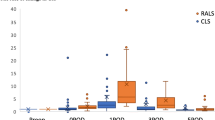Abstract
Purpose
The aim of the present study was to investigate whether renal dysfunction following rhabdomyolysis occurs after robot-assisted radical prostatectomy (RARP), and to investigate the factors related to rhabdomyolysis after RARP.
Methods
A total of 180 consecutive patients who underwent RARP at our institution were investigated. Rhabdomyolysis was defined as creatine kinase (CK) > 1050 IU/L after RARP. The association between CK and renal function after RARP was investigated, and the factors related to rhabdomyolysis after RARP were also investigated.
Results
Postoperative CK (407 ± 936 IU/L) was significantly higher than preoperative CK (134 ± 75 IU/L) (p < 0.001), and eGFR after RARP was significantly negatively correlated with CK on the day after RARP (correlation coefficient (ρ) = − 0.248, p = 0.007), but the significant negative correlation disappeared on the 7th day after RARP (ρ = − 0.010, p = 0.32). On multivariate analysis, postoperative CK elevation was significantly correlated with console time (p = 0.002). Rhabdomyolysis was observed in 6.1% (11/180), and of the patients with rhabdomyolysis, acute renal failure was transiently observed in 45.5% (5/11). On multivariate analysis, rhabdomyolysis was significantly associated with higher body mass index (BMI) (> 25.7 kg/m2) and longer console time (> 188 min) (p = 0.02 and p = 0.005, respectively).
Conclusion
Temporary renal dysfunction can occur after RARP due to CK elevation. Thus, sufficient attention must be paid to renal insufficiency after elevation of CK values for several days after RARP. Because rhabdomyolysis after RARP was associated with both obesity and long console time, console time during RARP should be shortened, especially in patients with obesity.




Similar content being viewed by others
References
Kurokawa S, Umemoto Y, Mizuno K, Okada A, Nakane A, Nishio H, Hamamoto S, Ando R, Kawai N, Tozawa K, Hayashi Y, Yasui T (2017) New steps of robot-assisted radical prostatectomy using the extraperitoneal approach: a propensity-score matched comparison between extraperitoneal and transperitoneal approach in Japanese patients. BMC Urol 17(1):106. https://doi.org/10.1186/s12894-017-0298-z
Gorgen ARH, Pavlovich CP (2018) Easy, reproducible extraperitoneal pelvic access for robot—assisted radical prostatectomy. Int Braz J. https://doi.org/10.1590/s1677-5538.ibju.2018.0175
Vijay MK, Vijay P, Kundu AK (2011) Rhabdomyolysis and myogloginuric acute renal failure in the lithotomy/exaggerated lithotomy position of urogenital surgeries. Urol Ann 3(3):147–150. https://doi.org/10.4103/0974-7796.84965
Raza A, Byrne D, Townell N (2004) Lower limb (well leg) compartment syndrome after urological pelvic surgery. J Urol 171(1):5–11. https://doi.org/10.1097/01.ju.0000098654.13746.c4
Bocca G, Van Moorselaar JA, Feitz WFJ, Van Der Staak FHJM, Monnens LAH (2002) Compartment syndrome, rhabdomyolysis and risk of acute renal failure as complications of the lithotomy position. J Nephrol 15(2):183–185
Pridgeon S, Bishop CV, Adshead J (2013) Lower limb compartment syndrome as a complication of robot-assisted radical prostatectomy: the UK experience. BJU Int 112(4):485–488. https://doi.org/10.1111/bju.12201
Knochel JP (1993) Mechanisms of rhabdomyolysis. Curr Opin Rheumatol 5(6):725–731
Huerta-Alardín AL, Varon J, Marik PE (2005) Bench-to-bedside review: rhabdomyolysis—an overview for clinicians. Crit Care 9(2):158–169. https://doi.org/10.1186/cc2978
Brown CVR, Rhee P, Chan L, Evans K, Demetriades D, Velmahos GC (2004) Preventing renal failure in patients with rhabdomyolysis: do bicarbonate and mannitol make a difference? J Trauma Inj Infect Crit Care 56(6):1191–1196
Kim TK, Yoon JR, Lee MH (2010) Rhabdomyolysis after laparoscopic radical nephrectomy—A case report. Korean J Anesthesiol 59(Suppl):S41–44. https://doi.org/10.4097/kjae.2010.59.S.S41
Chakravartty S, Sarma DR, Patel AG (2013) Rhabdomyolysis in bariatric surgery: a systematic review. Obes Surg 23(8):1333–1340. https://doi.org/10.1007/s11695-013-0913-3
Faintuch J, De Cleva R, Pajecki D, Garrido AB Jr, Cecconello I (2006) Rhabdomyolysis after gastric bypass: severity and outcome patterns. Obes Surg 16(9):1209–1213. https://doi.org/10.1381/096089206778392202
Reisiger KE, Landman J, Kibel A, Clayman RV (2005) Laparoscopic renal surgery and the risk of rhabdomyolysis: diagnosis and treatment. Urology 66(5 SUPPL.):29–35. https://doi.org/10.1016/j.urology.2005.06.009
Gelpi-Hammerschmidt F, Tinay I, Allard CB, Su LM, Preston MA, Trinh QD, Kibel AS, Wang Y, Chung BI, Chang SL (2016) The contemporary incidence and sequelae of rhabdomyolysis following extirpative renal surgery: a population based analysis. J Urol 195(2):399–405. https://doi.org/10.1016/j.juro.2015.08.084
Karaoren G, Bakan N, Kucuk EV, Gumus E (2017) Is rhabdomyolysis an anaesthetic complication in patients undergoing robot-assisted radical prostatectomy? J Minimal Access Surg 13(1):29–36. https://doi.org/10.4103/0972-9941.181291
Mattei A, Di Pierro GB, Rafeld V, Konrad C, Beutler J, Danuser H (2013) Positioning injury, rhabdomyolysis, and serum creatine kinase-concentration course in patients undergoing robot-assisted radical prostatectomy and extended pelvic lymph node dissection. J Endourol 27(1):45–51. https://doi.org/10.1089/end.2012.0169
Sakuta H, Suzuki T (2008) Overweight male personnel of the Japan Self-Defense Forces with body mass indices of 23.0-24.9 and obesity-related metabolic disorders. Environ Health Prev Med 13(2):116–120
Mehta RL, Kellum JA, Shah SV, Molitoris BA, Ronco C, Warnock DG, Levin A, the Acute Kidney Injury N (2007) Acute Kidney Injury Network: report of an initiative to improve outcomes in acute kidney injury. Crit Care 11(2):R31–R31. https://doi.org/10.1186/cc5713
Mognol P, Vignes S, Chosidow D, Marmuse JP (2004) Rhabdomyolysis after laparoscopic bariatric surgery. Obes Surg 14(1):91–94. https://doi.org/10.1381/096089204772787356
Pariser JJ, Pearce SM, Patel SG, Anderson BB, Packiam VT, Shalhav AL, Bales GT, Smith ND (2015) Rhabdomyolysis after major urologic surgery: epidemiology, risk factors, and outcomes. Urology 85(6):1328–1332. https://doi.org/10.1016/j.urology.2015.03.018
Harper JD, Baron PW, Ojogho ON, Baldwin DD (2007) Incidence of increased creatine kinase and its effect on kidney function in hand assisted laparoscopic kidney donors and their recipients. J Urol 178(4):1391–1395. https://doi.org/10.1016/j.juro.2007.05.130
Sidana A, Walton-Diaz A, Truong H, Siddiqui MM, Miao N, Shih J, Mannes A, Bratslavsky G, Linehan WM, Metwalli AR (2016) Postoperative elevation in creatine kinase and its impact on renal function in patients undergoing complex partial nephrectomy. Int Urol Nephrol 48(7):1047–1053. https://doi.org/10.1007/s11255-016-1284-1
Acknowledgements
The author thanks everyone involved in this paper.
Author information
Authors and Affiliations
Corresponding author
Ethics declarations
Conflict of interest
The authors have no conflict of interest to report.
Informed consent
Informed consent was obtained from all individual participants included in the study.
Additional information
Publisher's Note
Springer Nature remains neutral with regard to jurisdictional claims in published maps and institutional affiliations.
Rights and permissions
About this article
Cite this article
Onagi, A., Haga, N., Tanji, R. et al. Transient renal dysfunction due to rhabdomyolysis after robot-assisted radical prostatectomy. Int Urol Nephrol 52, 1877–1884 (2020). https://doi.org/10.1007/s11255-020-02500-3
Received:
Accepted:
Published:
Issue Date:
DOI: https://doi.org/10.1007/s11255-020-02500-3




